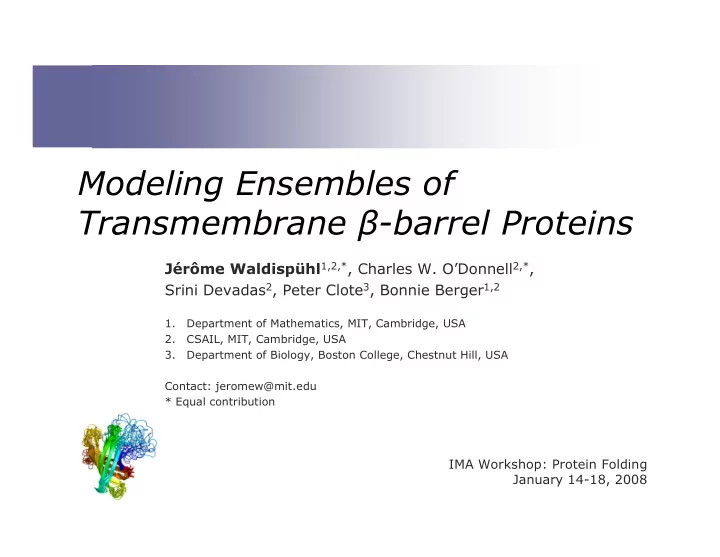

Modeling Ensembles of Transmembrane � -barrel Proteins Jérôme Waldispühl 1,2,* , Charles W. O’Donnell 2,* , Srini Devadas 2 , Peter Clote 3 , Bonnie Berger 1,2 1. Department of Mathematics, MIT, Cambridge, USA 2. CSAIL, MIT, Cambridge, USA 3. Department of Biology, Boston College, Chestnut Hill, USA Contact: jeromew@mit.edu * Equal contribution IMA Workshop: Protein Folding January 14-18, 2008
Overview Objective: Compute statistical properties of ensembles of structures rather than predicting a single structure. Target: Transmembrane � -barrel proteins. Method: Calculate the partition function over TMB structures and analyze the Boltzmann distribution. Principles: • Describe the conformational space: Abstract template (grammar). • Weight the structure: Energy function. • Efficient algorithm: Dynamic programming. 2/15
Transmembrane � -barrel proteins TMBs: Found in outer-membranes ( gram-negative bacteria, Mitochondria) � Important for signaling, drugs, etc Difficult to solve with X-Ray/NMR techniques, � 20 non-homologous structures in PDB. TM barrel fold highly conserved across species, � but high sequence variability (Schultz’00). TMBs undergo conformational changes in vivo (Tamm’04). � 3/15
Modeling with grammars 2-tape grammar model TMB protein containing only � � –strands and loops/random-coils Property: Anti-parallel strand pairs are isolated. 4/15
Modeling with grammars (2) Strand inclination (shear) and variable strand length handled by strand � extensions: Left pairing Right pairing Distinguish side-chain orientation ( M : Membrane, C : Channel) � 5/15
Energy model Instead of pairwise interactions (BETAWRAP), consider stacking pairs: � E ( i , j , x | i 2 , j 2 ) + + = ( ) ( ) RT log p RT log Q � � i , j , x | i 2 , j 2 tmb + + Requires 2 � 20 4 values of p i,j,x so must use reduced alphabet. � Potentials computed from a dataset of globular proteins to overcome the small � dataset problem. Distinguish interaction environment by similarity: � Membrane=Buried, Channel=Exposed. 6/15
Multi-tape S-Attribute Grammars Parse of tree gives structure, � Node labeled with energy, � Additionnal constraints � can be added to each node. 7/15
Boltzmann ensembles Boltzmann Partition Function E ( s ) / RT Q ( s ) e � � = � s S ( s ) � Encodes statistical mechanical properties of the system: � A E ( s ) � � � A RT ln Q ( s ) 2 E ( s ) RT ln Q ( s ) S = � C = � = = T T T � � � Efficient algorithms using dynamic programming principles. � grammar allows to use parsing algorithm (CKY, Earley, GCP…) Output: � Partition function value, � Stochastic backtracking: Structure sampling, � Residue interaction probability. � Allows: � Whole structure prediction through clustering of samples, � Residue contact prediction, � Prediction of B-value (reproduce experimental observation). � 8/15
Results: Residue contact probability Residue index Partition function of all TMBs with contact (i,j): Residue index E ( s ) / RT � Q ( i , j ) e � ( i , j ) = s S � ( i , j ) Contact probability: Q ( i , j ) p ( i , j ) = Q tmb p(i,j) assembled in a stochastic contact map : Red: Crystal structure Green: M.F.E. structure Upper triangle: Membrane Lower triangle: Channel Can be used to help reconstruct 3D models (Grana’05, Punta’05) 9/15
Results: Residue contact probability (2) Prediction of contacts by filtering p(i,j) � p c Accuracy % Coverage: TP/(TP+FN) Accuracy: TP/(TP+FP) F-measure: # contacts in x-ray struct (2 � cov � acc)/(cov+acc) Accuracy Comparison with BETApro (general � -strand predictor; All contacts where p(i,j) > p c Cheng&Baldi, 2005) Probability p c ompX F-measure 1QJ8 1P4T 1QJP 1THQ 1TLY 1K24 1I78 1QD6 peak partiFold 0.66 0.38 0.27 0.18 0.43 0.40 0.27 0.16 BETApro 0.49 0.14 0.22 0.05 0.08 0.56 0.15 0.66 10/15
Results: B-value prediction n Contact probability profile P cp (i) () � � P i p = cp ( i , j ) Frequency of � –strand pairing per residue � j 1 = Debye-Waller factor ( B-value ) in x-ray crystal structures � Indicates uncertainty or disorder in crystal � Higher values of � P cp (i) and B-value indicate more flexible regions (eg. loops) Match the performance � of PROFbval (Schlessinger&Rost,2005) Residue index ompX 11/15
Results: Whole structure prediction Sample structures, identify substructure probabilities. � Clustering gives multiple compact � clusters of conformations ompX Red: Crystal structure Green: M.F.E. structure Representants of clusters provide better candidates and outperform � the minimum folding energy structure. 12/15
Webserver http://partifold.csail.mit.edu Tunable structural constraints and energy model, fast, permanently updated. Binary distribution is also provided. 13/15
Acknowledgments MIT Ecole Polytechnique • Charles W. O’Donnell • Jean-Marc Steyaert • Mieszko Lis • Nathan Palmer Boston College • Srinivas Devadas • Peter Clote • Bonnie Berger Whitehead • Susan Lindquist • Rajaraman Krishnan 14/15
References � J. Waldispühl*, C.W. O'Donnell*, S. Devadas, P. Clote and B. Berger. Modeling Ensembles of Transmembrane � -barrel Proteins PROTEINS: Structure, Function and Bioinformatics, published online 14 Nov. 2007. doi:10.1002/prot.21788 (* authors equally contributed) � J. Waldispühl, B. Berger, P. Clote and J.-M. Steyaert, Predicting Transmembrane � -barrels and Inter-strand Residue Interactions from Sequence. PROTEINS: Structure, Function and Bioinformatics, vol. 65, issue 1, p.61-74, 2006. doi:10.1002/prot.21046 � J. Waldispühl and J.-M. Steyaert, Modeling and Predicting All- � Transmembrane Proteins Including Helix-helix Pairing, Theoretical Computer Science, special issue on Pattern Discovery in the Post Genome, p.67-92, 2005. doi:10.1016/j.tcs.2004.12.018 Current and future work presented in the poster: Modeling structure ensemble of conserved � -sheet folds Presenter: Charles O’Donnell 15/15
Recommend
More recommend